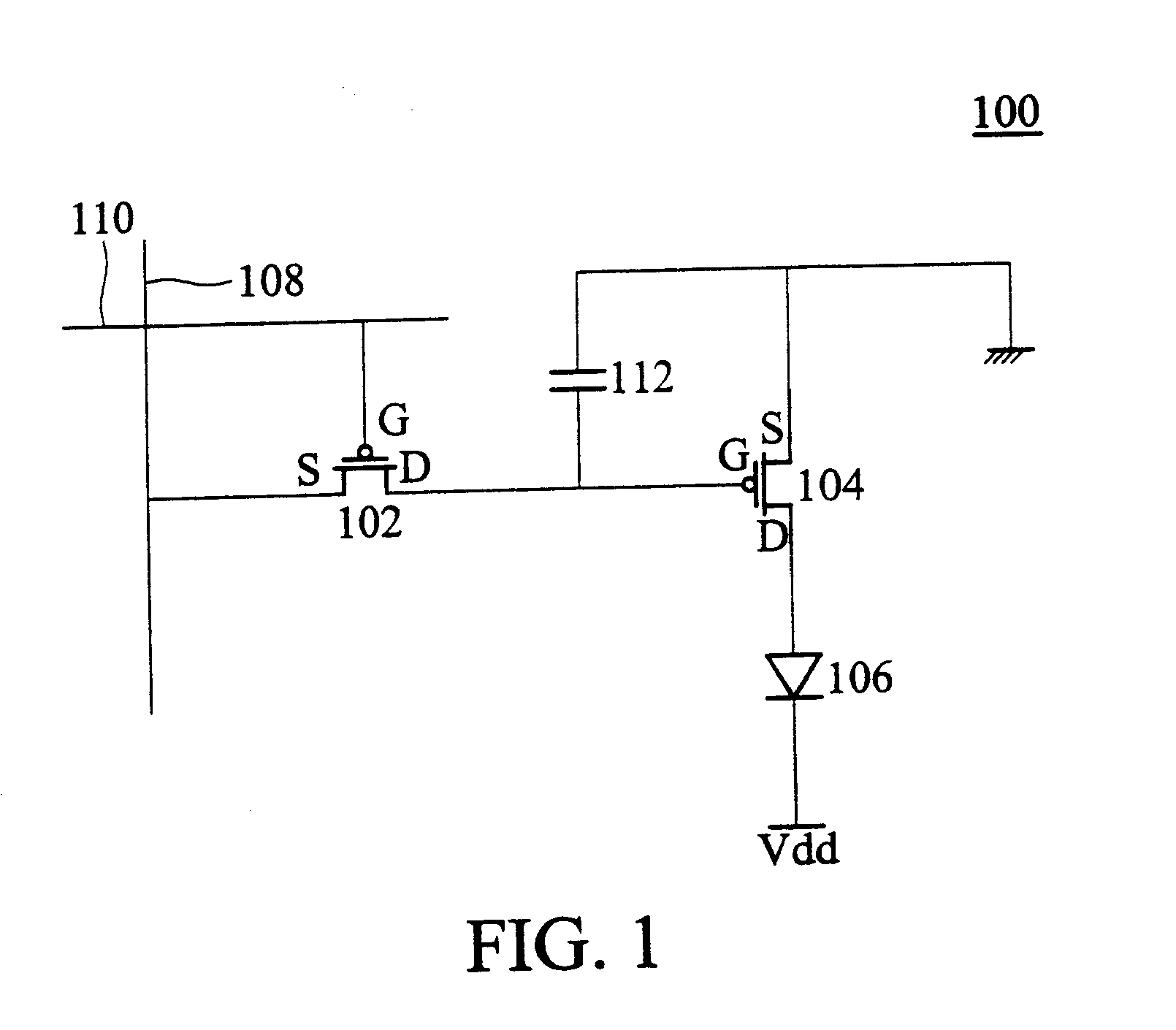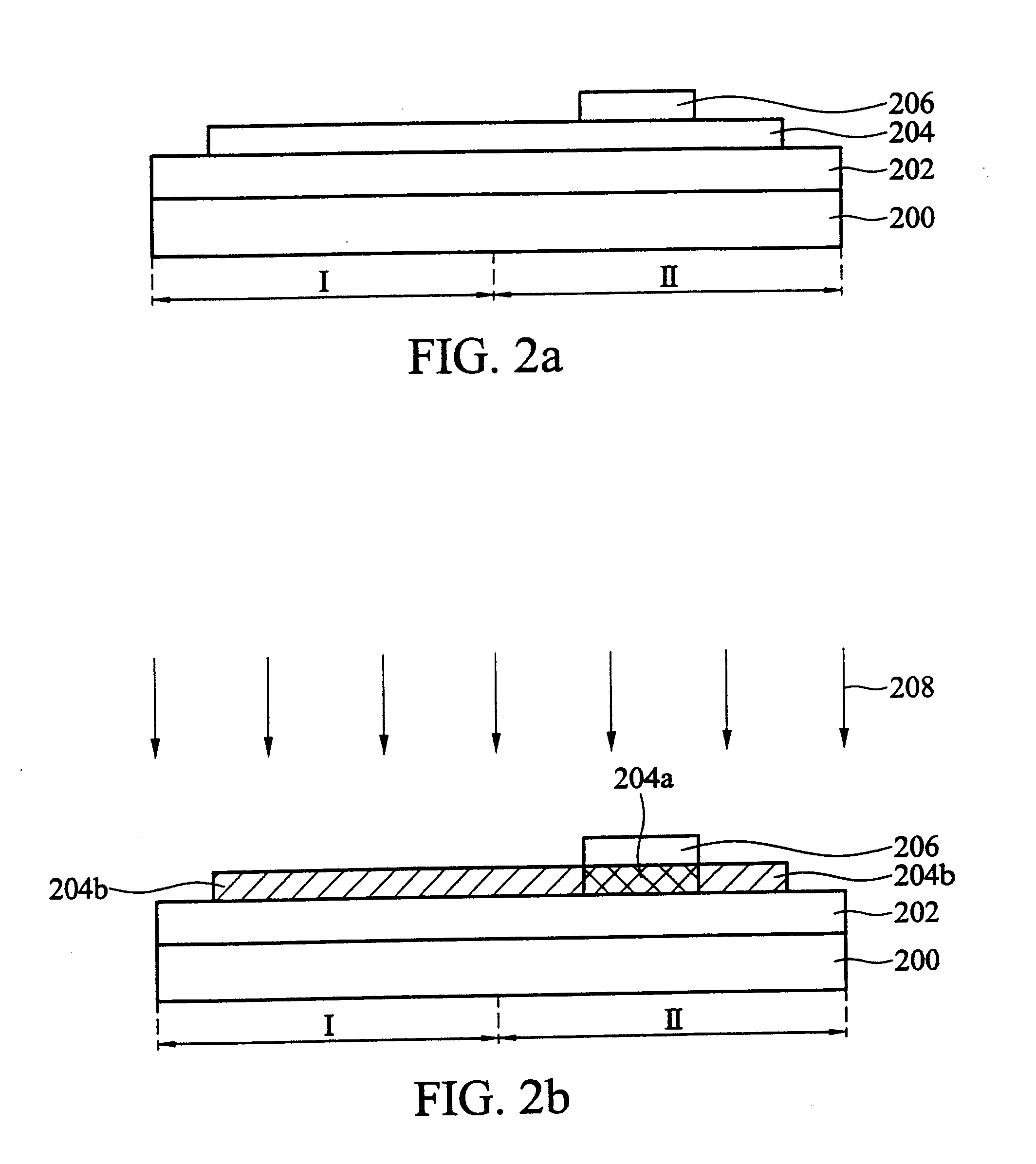Method of fabricating an organic electroluminescent device and system of displaying images
a technology of electroluminescent devices and images, applied in the direction of electrical instruments, electric digital data processing, instruments, etc., can solve the problem of non-uniform luminance between pixels rendering defects such as mura, and achieve the effect of reducing the difference of electric properties and increasing apertur
- Summary
- Abstract
- Description
- Claims
- Application Information
AI Technical Summary
Benefits of technology
Problems solved by technology
Method used
Image
Examples
first embodiment
[0024]FIGS. 2a-2f are cross sections showing an embodiment of a method for fabricating an organic electroluminescent device.
[0025]As shown in FIG. 2a, a buffer layer 202, an amorphous silicon layer 204 and a protection film 206 are formed sequentially overlying a substrate 200 divided into a first region (for example, a switching TFT region I) and a second region (for example, a driving TFT region II). The protection film 206 is formed on a portion of the amorphous silicon layer 204 in the second region II, and includes silicon-based materials such as SiOx, SiNx, SiOxNy or a stack of SiOx, SiNx.
[0026]As shown in FIG. 2b, the amorphous silicon layer 204 proceeds an excimer laser annealing (ELA) process 208 and transforms to polysilicon layers 204a and 204b. The polysilicon layers 204a and 204b, however, have different grain size because the protection film 206 can reflect a portion laser in the excimer laser annealing (ELA) process 208. That is, the polysilicon layer 204b uncovered b...
second embodiment
[0030]FIGS. 3a-3f are cross-sections showing an embodiment of a method for fabricating an organic electroluminescent device.
[0031]As shown in FIG. 3a, a buffer layer 302 and amorphous silicon layer 304 are formed sequentially overlying a substrate 300 divided into a switching TFT region I and a driving TFT region II.
[0032]As shown in FIG. 3b, the amorphous silicon layer 304 is patterned, thus a patterned amorphous silicon layer 304b in the switching TFT region I and a patterned amorphous silicon layer 304a in the driving TFT region II are formed.
[0033]As shown in FIG. 3c, a protection film 306 is formed covering the patterned amorphous silicon layer 304a and a portion of the buffer layer 302, and includes silicon-based materials such as SiOx, SiNx, SiOxNy or a stack of SiOx, SiNx.
[0034]As shown in FIG. 3d, the patterned amorphous silicon layers 304a and 304b proceeds an excimer laser annealing (ELA) process 308 and transforms to polysilicon layers 304c and 304d. The polysilicon laye...
third embodiment
[0037]FIGS. 4a-4g are cross sections showing an embodiment of a method for fabricating an organic electroluminescent device.
[0038]As shown in FIG. 4a, a protection film 402 is formed overlying a substrate 400 divided into a switching TFT region I and a driving TFT region II. The protection film 402 includes silicon-based materials such as SiOx, SiNx, SiOxNy or a stack of SiOx, SiNx.
[0039]As shown in FIG. 4b, a buffer layer 404 is formed overlying the patterned protection film 402 and the substrate 400. As shown in FIG. 4c, an amorphous silicon layer 406 is formed overlying the buffer layer 404.
[0040]As shown in FIG. 4d, the amorphous silicon layer 406 proceeds an excimer laser annealing (ELA) process 408 and transforms to polysilicon layers 406a and 406b.
[0041]As shown in FIG. 4e, patterned polysilicon layers 406′a and 406b are formed after a patterning process of the polysilicon layers 406a and 406b. The polysilicon layers 406′a in the switching TFT region I serves a first active ...
PUM
| Property | Measurement | Unit |
|---|---|---|
| grain size | aaaaa | aaaaa |
| heat | aaaaa | aaaaa |
| insulating | aaaaa | aaaaa |
Abstract
Description
Claims
Application Information
 Login to View More
Login to View More - R&D
- Intellectual Property
- Life Sciences
- Materials
- Tech Scout
- Unparalleled Data Quality
- Higher Quality Content
- 60% Fewer Hallucinations
Browse by: Latest US Patents, China's latest patents, Technical Efficacy Thesaurus, Application Domain, Technology Topic, Popular Technical Reports.
© 2025 PatSnap. All rights reserved.Legal|Privacy policy|Modern Slavery Act Transparency Statement|Sitemap|About US| Contact US: help@patsnap.com



